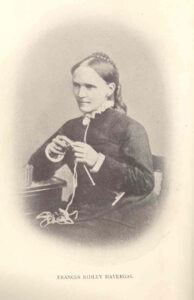GUEST POST by Andy Naselli
It’s time to address two little controversies raised in the comments of two previous posts about Keswick theology on this blog.
1. What about Keswick today?
The Keswick Convention today is much different than it was in its first generation. What I call “Keswick theology” summarizes the theology of Keswick’s first generation (1875–1920), not Keswick today.
Case in point: Don Carson is speaking at the Keswick Convention next week!

2. Is Frances Havergal really connected to Keswick theology?
I asserted that the hymnody of Frances Ridley Havergal (1836–1879) is connected to Keswick theology, and a few people dissented. I’m not an expert on Havergal’s hymnody, so I may be missing something. Here’s what I write about it in Let Go and Let God? A Survey and Analysis of Keswick Theology:
“Fannie,” as her family and friends affectionately called her, was an Anglican hymnist, poet, and devotional author. She turned down several marriage proposals and never married. Her father was a musically gifted Anglican clergyman, and she had a gifted mind for languages and music, which she employed especially for the last six years of her life after 2 December 1873, the day that “marked the crisis of the exchanged life” for her.[1] She had already become well known for her hymns, but she then became closely associated with the Keswick Convention (as well as other gatherings such as the Mildmay Conference and Moody and Sankey’s meetings). She became known as “the consecration poet,” and she “thus was able before her early death to write those hymns indelibly identified with Keswick: Like a river glorious is God’s perfect peace [1878] and Take my Life and let it be [1874].”[2]
In 1880 The Life of Faith carried an article on “Miss Havergal’s experience of the Deeper Life.” Particular attention was paid to the words of the hymn “Take my life and let it be.” This composition, it was suggested, “may be said to have lifted Christians of all denominations to a higher standard of devotedness, and has preached the doctrine of the Deeper Life in a most engaging and persuasive manner.”[3]
“Like a River Glorious” “was seen as summing up the Convention message about entering into ‘God’s perfect peace.’”[4] In the first stanza of her hymn “I Am Trusting Thee, Lord Jesus” (1874), she writes, “Trusting Thee for full salvation, / Great and free.” In addition to her devotional books and booklets such as Kept for the Master’s Use (1879), she wrote approximately fifty hymns and two hundred poems. She was “the British equivalent of Fanny Crosby” and “was crucial to Keswick,” where her “significance as an author was unrivalled.”[5]
[1] V. R. Edman, They Found the Secret: Twenty Transformed Lives That Reveal a Touch of Eternity (Grand Rapids: Zondervan, 1960), 72. Havergal wrote to her sister Maria, “Yes, it was on Advent Sunday, December 2nd, 1873, I first saw clearly the blessedness of true consecration. I saw it as a flash of electric light, and what you see you can never unsee. There must be full surrender before there can be full blessedness. . . . I just utterly yielded myself to Him, and utterly trusted Him to keep me” (74).
[2] J. C. Pollock, The Keswick Story: The Authorized History of the Keswick Convention (Chicago: Moody, 1964), 16.
[3] Charles W. Price and Ian Randall, Transforming Keswick: The Keswick Convention, Past, Present and Future (Carlisle: OM, 2000), 85–86; cf. Life of Faith, 1 July 1880, 127. Havergal’s hymn begins, “Take my life, and let it be / Consecrated, Lord, to Thee.”
[4] Price and Randall, Transforming Keswick, 86. The chorus reads, “Stayed upon Jehovah, / Hearts are fully blest, / Finding as He promised, / Perfect peace and rest.” F. S. Webster turns to this “noble refrain” to answer the question “What is the distinctive ‘Keswick’ note?” “Keswick Hymns,” in The Keswick Convention: Its Message, Its Methods and Its Men (ed. Charles F. Harford; London: Marshall Brothers, 1907), 214.
[5] Price and Randall, Transforming Keswick, 85. For more information on Keswick hymnody, see Webster, “Keswick Hymns,” chap. 18 in The Keswick Convention: Its Message, Its Methods and Its Men (ed. Charles F. Harford; London: Marshall Brothers, 1907), 211–20; Price and Randall, Transforming Keswick, 84–94, 103; Mrs. Evan [Isabella] Hopkins, comp., Hymns of Consecration and Faith—for Use at General Christian Conferences, Meetings for the Deepening of the Spiritual Life, and Consecration Meetings (London: Marshall, Morgan & Scott, 1890).


